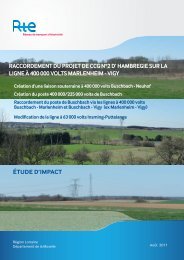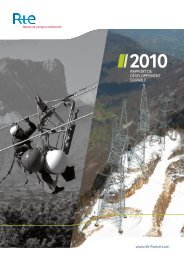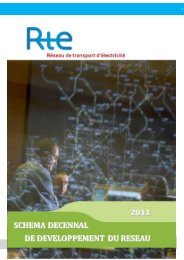Power System Reliability Report - RTE
Power System Reliability Report - RTE
Power System Reliability Report - RTE
- No tags were found...
You also want an ePaper? Increase the reach of your titles
YUMPU automatically turns print PDFs into web optimized ePapers that Google loves.
R-AUDIT-SG-DAR-MAS-11-2011/022010 <strong>Reliability</strong> <strong>Report</strong>Page : 11/408 juillet 2011month ever since the start of these observations. It should be noted that during these periods inwhich the frequency is lower or close to “Fref – 100 mHz”, the European system has almost fully usedup its primary reserve and can therefore not cope as planned with a sudden major loss in generation,with the associated risk of requiring an automatic frequency related load shedding operation tomanage the consequences. The total duration of the exposure to this risk was 6400s during the year(3700s in 2009). Happily, the mean duration of these variations remains very limited at 43s (39s),illustrating the effects of the controls and the actions of the TSO operators to resolve them. Thelongest one did reach 6min and 20s (4 min 40s). These frequency variations are essentially the resultsof important changes in exchange programs at the interconnections between countries, on the hour,and are also due to the shutdowns/start-ups of the associated units; current practices don‟t make itpossible to sufficiently reduce the impact. They also lead to large variations in physical flows on theinterconnections: for example, on January 13 th at 23:00, the flow from Spain to France was for a fewminutes 1300 MW instead of the 530 MW planned. The operational implementation in 2010 of aEuropean task force with members from the TSOs/Producers/Market companies, that made it possibleto share observations and possible solutions with all the stakeholders, opens up new encouragingprospects to reduce this risk, but in late 2010, there weren‟t yet any tangible conclusions.2.3 Voltage stabilityThe main operating challenge for <strong>RTE</strong> in 2010 remained ensuring reliability faced with the risk ofvoltage collapse, mainly during periods of high consumption. Previous reports have shown thestructural difficulties for control in a large western region and in PACA (South-East of France):shortage of well-located production facilities in these zones, difficulties in building transmissionfacilities, and growth in regional consumption levels. The “Brittany electrical pact” agreed between theregion, the State, <strong>RTE</strong>, the ADEME and the ANAH and signed on December 14 th plans for investments(invitation to tender for a combined cycle power plant near Brest and reinforcement of the northsouth225 kV network) over the next few years to reduce these difficulties. For the time being, thestructural difficulties were aggravated in the western region as of 2009 by major limitations in reactivepower production capacities on generating units.In line with previous years, <strong>RTE</strong> continued its on-going adaptation actions in 2010, by using thefeedback from the last winters and by taking into account the expected lasting nature of reactivepower limitations for certain generating units over the next few years:- In terms of facilitiesThe installation of capacitors previously decided for Brittany and Normandy was continued.For 2011-2014, a major programme to build new compensation means in the northwestquarter was initiated, for a total of roughly 1800 MVAr, including several static VARcompensators that provide continuous and automatic regulation capacities to the voltageprofile. This programme also includes investments of 1750 MVAr of capacitors (of which 1200in 400 kV) in the South-West, the reinforcement of the interconnection between France andSpain, and 320 MVAr in the North-East.The passage to 400 kV of the second three-phase circuit of the only double line betweenToulon and Nice (Néoules – Trans – Briançon - Broc-Carros line) was finalized in mid-2010.- In terms of control methods, improvements to the tools (Convergence -cf §4.1.5) and theprogressive adaptation of the organisations made it possible to make decisions in real time to call onsafeguard means, by using dynamic simulations carried out on more precise data sets (instantaneousregional points included in a single complete data set) replacing less precise static criteria; in 2009,these dynamic studies were used on day ahead data. The methods and organization of day aheadforecasting studies were also improved -cf §5.6-.The development of the Ecowatt programme in Brittany and in the South-East also contributed tocontrolling these daily peaks by encouraging citizens to reduce their consumption.From a factual point of view, in line with the end of 2009, the passage of consumption peaks duringcold spells from January to March 2010 remained very tense. Many times, <strong>RTE</strong> had to resort towarning and then safeguard orders. These orders are activated so as to ensure electrical systemcapacity in order to avoid a large-scale voltage collapse (regional or more) during the occurrence ofpotential incidents that are fairly common (loss of a 400 kV line or a large production unit in theregion) or quite rare but with very large consequences (loss of a busbar section in a 400 kV substationCopyright <strong>RTE</strong>. This document is the property of <strong>RTE</strong>. Any communication, reproduction, publication even partial is forbidden without the express written authorisationElectricity Transmission <strong>System</strong> operator (<strong>RTE</strong>)
















